
Qo'noS from space
Klingon history is the violent but colorful history of the Klingon people and their empire.
Early history[]
Evolution[]
Origin of the Klingon people[]

Kortar, the "first Klingon" according to lore, as seen in a vision
A "Garden of Eden"-like place known as Qui'Tu played a role in Klingon creation myths. Kortar, the first Klingon, along with his mate, were created by gods whom they subsequently destroyed. (Star Trek V: The Final Frontier; DS9: "You Are Cordially Invited"; VOY: "Barge of the Dead")
In 2369, evidence was discovered, which suggested that many of the galaxy's humanoid races were descended from a single humanoid race, who were the originators of the basic anatomy. Around 4.5 billion years ago, they had seeded many worlds with a DNA code to guide evolution to a form resembling their own. Klingons displayed evidence of these DNA sequences. (TNG: "The Chase")
Birth of the Klingon Empire[]

A computer image of a Klingon mummification glyph
Klingons, at one point, practiced mummification. Caskets with Klingon corpses dating back "thousands of years" before 2256 were incorporated in the ceremonial armor of the Sarcophagus. Allegedly, Molor was also mummified. (DIS: "The Vulcan Hello"; Star Trek IV: The Voyage Home; TNG: "Firstborn")
The script of Star Trek IV: The Voyage Home identified the mummification glyph as being from the early Zanxthkolt Dynasty.
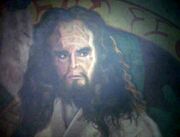
A painting of Kahless on Boreth
According to Klingon lore, Qo'noS, the Klingon homeworld, was ruled by Molor in the 10th century AD. While Molor was a tyrannical dictator who was generally unpopular among the people, the chimneys of the planet's volcanoes housed shrines in which live sacrifices were thrown in his honor. Kahless the Unforgettable, a commoner, emerged as a champion of the people, and stood against Molor's troops at Qam-Chee. Here, Kahless and the Lady Lukara fought a pitched battle in the city's Great Hall while the rest of the city's garrison fled before the five hundred soldiers. Shortly after their victory, the two began what became known as the greatest romance in Klingon history. Kahless eventually slew Molor in single combat at the River Skral using the first bat'leth, the Sword of Kahless – an event that centuries later was still celebrated in the Empire through the Kot'baval Festival. (DIS: "Will You Take My Hand?"; TNG: "Rightful Heir", "Firstborn"; DS9: "Looking for par'Mach in All the Wrong Places")
The exact time period in which Kahless lived has repeatedly been described with differing numbers. In DS9: "Looking for par'Mach in All the Wrong Places" (taking place in 2373), Worf enthusiastically mentions the events in Qam-Chee to have happened "a thousand years ago." In "Rightful Heir", Gowron also states that Kahless has been dead "a thousand years." "Soldiers of the Empire" states that 2373 corresponds to "the year of Kahless 999", which could indicate Kahless' lifetime to have been around 1374 AD. Although these three statements place Kahless' lifetime in the 14th and not the 10th century, it should be taken into account that the length of a Klingon year is unlikely to equal an Earth year, and might, therefore, be longer. Moreover, "Rightful Heir" mentions the monks on Boreth had been awaiting Kahless' return for "fifteen centuries," i.e. five hundred years longer. This is also in accord with the Sword of Kahless being dated to an age of 1,400 years in DS9: "The Sword of Kahless". Furthermore, a scene cut from "Rightful Heir" had Data specify Kahless' death as 1,547 years ago, which places it in 822 AD. Given the scientific dating in "The Sword of Kahless", this figure is the most reliable, placing the creation of the Sword of Kahless in the latter half of the 10th century.

A surviving shrine to Molor on Qo'noS as seen in 2257
After Molor's defeat, his temples were abandoned and built over. However, followers of Molor, who had their own traditions, would continue to openly exist as late as the mid-23rd century. (DIS: "Will You Take My Hand?")
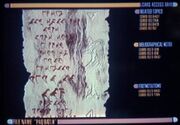
An excerpt of the paq'batlh, a large series of ancient Klingon scrolls and religious texts, that, among other things, passed on the stories of Kahless
Despite his low birth, Kahless ruled, together with his new wife, as Emperor of Qo'noS, establishing the First Empire. He would also conquer the Fek'Ihri and come into conflict with his brother, Morath. Kahless proved to be not only a powerful warrior, but also a wise ruler, establishing a code of honor that was to become the template for Klingon society for centuries to come. Kahless was also a philosopher and his words were frequently invoked by warriors about to enter battle. Among his sayings were "A leader is judged not by the length of his reign, but by the decisions he makes." Kahless' legends were recorded in a series of scrolls called the paq'batlh. (TNG: "New Ground"; DS9: "The Sword of Kahless", "Tacking Into the Wind"; VOY: "Barge of the Dead")
The fact that a clone of Kahless was unfamiliar with the concept of cloning could suggest that Klingons did not yet possess this technology during Kahless' original lifetime. However, the clone's mind and memory were constructed by 24th century monks based on historical text, and might, therefore, be incomplete or erroneous. A cut scene from "Rightful Heir" might also suggest Klingons practiced slavery at this time, as Kahless mistook Troi for a gift to him.

Boreth and its moon, as seen in 2257
Sometime after Kahless united all Klingons, he left. Claiming that he was going to Sto-vo-kor, he pointed to a star and said, "Look for me there, on that point of light." A planet orbiting the star Kahless pointed out was later named Boreth, becoming the most sacred place for Klingons. Based on the given promise, it was here where the Followers of Kahless henceforth awaited his return. (DIS: "Through the Valley of Shadows"; TNG: "Rightful Heir")
Whether Kahless' words may be interpreted with respect to the space-faring capabilities of Klingons at that time is not known. According to the reference book Star Trek: Star Charts, the Klingons first achieved warp capability in the Earth year 930 AD, i.e., during the time of Kahless. However, according to the manual for Star Trek: Klingon Academy, the Klingons acquired warp drive much later (14th century AD), from the Hur'q during their conquest of Qo'noS (see below).
The way to an interstellar empire[]
Kahless' greatest legacies included not only the creation of the Klingon Empire, but also establishing the position of Emperor, thereby founding a dynastic monarchy that endured almost uninterrupted for over 1,000 years. Noted emperors included Sompek, remembered for his conquest of Tong Vey, when ten thousand of his warriors laid siege to the city. When Sompek captured Tong Vey, he ordered the entire population massacred, and the city burned to the ground. Emperor Mur'Eq, on the other hand, was known for introducing the use of blunted bat'leths for practice, in order to make sure "his warriors kill their enemies and not each other". (TNG: "Rightful Heir"; DS9: "Rules of Engagement"; VOY: "Prophecy")

The Sword of Kahless, one of the most important Klingon artifacts, was stolen by the Hur'q
In the 14th century, the Klingon homeworld was sacked by a powerful race from the Gamma Quadrant they called Hur'q (Klingonese for "outsider"). Although they did not stay long, the Hur'q did not leave before looting many valuable cultural treasures, including the revered Sword of Kahless. (ENT: "Affliction"; DS9: "The Sword of Kahless")
The simplistic term "outsider" for a specific alien race would be in agreement with the Hur'q being the first off-world species the Klingons ever encountered.
According to the Lost Era novel The Art of the Impossible as well as the Star Trek: Klingon Academy video game, the Klingons were able to reverse-engineer captured Hur'q technology, such as warp propulsion, which allowed them to become an interstellar power.
At one point, the Second Dynasty ruled over the Klingon Empire. It was ended when General K'Trelan assassinated Emperor Reclaw and later put to death all the members of the Imperial Family. During the next ten years, the Empire was ruled by a council elected by the people, which was referred to as "The Dark Time" by 24th century Klingon historians although it produced several notable reforms. Following this unique but brief period of democracy, a new group of Klingons, called the Third Dynasty, was given the titles and names of the original Imperial Family, in order to create the illusion of an unbroken line, since the true Imperial bloodlines were cut at the end of the Second Dynasty. (DS9: "You Are Cordially Invited")
As Sirella claimed her twenty-third maternal grandmother to have lived during these events, they should have taken place at least several hundred years before the 24th century.
Sirella apparently believed herself to be a descendant of an Emperor of the Klingon Empire, who, in turn, were said to all be descendants of Kahless. Thus, if Sirella truly believed herself to be a descendant of Kahless, this would contradict the believe that the last descendant of Kahless died in the 21st Century.
According to Quark, Klingons achieved warp drive sometime after 1947. By the year 2152, Klingon vessels were capable of warp 6. (DS9: "Little Green Men"; ENT: "Judgment")
According to the Star Trek: Star Charts (p. 55) Klingons had achieved warp capability in the year 930, which is a reference to the Boreth monastery being built shortly after Kahless' death. However, Quark specifically stated, in "Little Green Men", that the Ferengi would have had warp drive before the Klingons, had he delivered warp technology to Ferenginar in 1947. Adding to the impression that Quark might have been in error or exagerrating is that he also said the Vulcans, too, were not warp capable as of 1947, even though they were later explicitly shown to possess several warp-capable starships by 1957. See "Little Green Men" - Trivia for more information.
In 2016, a Vulcan ship crossed into Klingon space near H'atoria, prompting the Klingons to destroy it immediately. Not wanting to make the same mistake twice, the Vulcans henceforth fired first whenever they crossed paths with Klingons until formal diplomatic relations were established. As Commander Michael Burnham later put it, "They said 'hello' in a language the Klingons understood. Violence brought respect. Respect brought peace." (DIS: "The Vulcan Hello")
Sarek's "Vulcans don't make the same mistake twice" comment strongly implies that this was the first time they encountered Klingons, their first contact.
This event might potentially have been the "disastrous contact with the Klingon Empire" that led to decades of war that Picard spoke of in "First Contact". Initially, the statement was generally believed to refer to unremitting hostility after first contact in the 2220s, a theory endorsed by such reference works as the Star Trek Encyclopedia, 3rd ed., p. 244. After Star Trek: Enterprise established Human-Klingon first contact to have been in 2151, it was likewise assumed that the decades of war followed that date. However, Star Trek: Discovery's first episode, "The Vulcan Hello", cast this theory into doubt as well, by establishing that the Klingons entered a century of sparse contacts with the Federation shortly after the end of Enterprise.
In the mid-21st century, the imperial monarchy, which claimed to trace its origins to the legendary warrior Kahless, came to an end when the last Emperor died and the leadership of the Empire fell to the Chancellor of the Klingon High Council. (TNG: "Rightful Heir")
During the Second Empire, Chancellor Mow'ga sent a fleet to conquer the Breen, but it was never heard from again. (DS9: "'Til Death Do Us Part")
The time period of the Klingon "Second Empire" was not mentioned on screen. However, due to Chancellor Mow'ga's apparent authority, it was likely after the reign of the last Emperor ended.
According to Tuvok, it was due to the Klingons being outlaws, as well as their violent and brutal behavior, that the stability of the quadrant, as it was in the late 21st century, was not achieved again until the late 23rd century. (VOY: "Alliances")
22nd century[]
Internal divisions and external challenges[]

The Klingon capital on Qo'noS in 2151
By the 22nd century, the Klingons were a major regional power, fielding a formidable military, referred to as the Klingon Imperial Fleet. (ENT: "Judgment", "Divergence")
Klingon forays into space up until the middle of the century included a starship which attempted to enter the Delphic Expanse in 2133. When it reemerged, the entire crew was anatomically inverted but still alive. After this incident, the Klingon High Council forbade all ships from entering the Expanse. (ENT: "The Expanse") At least one Klingon starship had encountered the automated repair station by 2152, and lost a crew member to it. (ENT: "Dead Stop") Several years before 2154, the Organians, a race of massively powerful noncorporeal beings, covertly observed Klingons leaving behind a garbage dump on a planet. The Organians were studying how different ship crews were responding to a deadly, contagious silicon-based virus that their landing parties contracted on the planet. The Klingons were said to have denied the infected back aboard, and their commander eventually had their craft destroyed, killing the landing party. (ENT: "Observer Effect")
In the late 2140s and early 2150s, the Klingons were engaged in a fierce internal struggle that, while not amounting to actual civil war, threatened to become a more intense conflict. Numerous attacks had taken place throughout the empire that were blamed on various Klingon factions; it was not realized at the time that the attacks had actually been launched by the Cabal, who were taking orders from a mysterious individual who was an operative in the Temporal Cold War. (ENT: "Broken Bow")
Klingon society of this era was divided into several castes, including a warrior caste. While martial abilities and honor had always been important in Klingon society, the warrior caste became more influential during the 22nd century. Other professions were regarded as less important, with most young people aspiring to become warriors. According to Kolos, by 2153 every victory was regarded as bringing honor and glory, even one against an inferior, helpless enemy. The warrior caste also gained control over the Klingon legal system. (ENT: "Judgment")
Early contacts with Humans[]
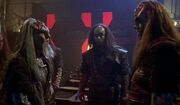
Klaang provides the Klingon High Council with proof that the Cabal was behind attacks against the Empire in 2151
Although the Klingons had occasional contact with the Vulcans since 2016, they had not met Humans until the Broken Bow Incident of 2151, in which a courier named Klaang crashed on Earth while pursued by two Suliban soldiers. After dispatching his two pursuers, Klaang was shot by a local farmer named Moore. The Vulcans quickly managed to convince the Klingons to let them take Klaang's corpse to Qo'noS, appeasing the Empire somewhat for the time being. However, although Vulcan Ambassador Soval then advised that Starfleet authorities withhold medical treatment and allow Klaang to die, Captain Jonathan Archer intervened and insisted on returning Klaang to Qo'noS alive aboard his ship, Enterprise NX-01.
Archer, however, did not understand the complexity or importance of Klingon tradition, and did not realize that returning Klaang to Qo'noS was a grave dishonor and insult. However, encoded in his DNA, Klaang carried with him proof that the attacks had in fact been launched by the Suliban, which averted a civil war. For this service, Archer and his ship were allowed to leave peacefully. (ENT: "Broken Bow")
Klingon forces encountered the Enterprise several times throughout 2151 and 2152. In one of those incidents, the Klingons gained access to holographic technology from the Xyrillians. (ENT: "Unexpected") In another contact, the Enterprise assisted the IKS Somraw, which had been raiding a Xarantine outpost, escape from the atmosphere of a class 9 gas giant. (ENT: "Sleeping Dogs") In a more violent confrontation, the Starfleet vessel assisted the residents of a deuterium facility defend against a group of Klingon marauders led by Korok. (ENT: "Marauders")
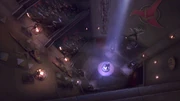
Earth Starfleet Captain Archer, "enemy of the [Klingon] state", being tried on Narendra III in 2153
In early 2153, the Empire again encountered Enterprise when the Human ship rescued a refugee ship from Raatooras that was attempting to flee Klingon territory. Captain Archer chose to render assistance to the refugees, but failed to realize the ramifications of his actions, particularly the embarrassment he would cause the Klingons. When the Klingons demanded that the refugees be handed over for trial, Archer refused to comply. Captain Duras of the IKS Bortas intercepted the Enterprise and attacked it, unsuccessfully. Archer was later captured and brought to trial on Narendra III, a Klingon colony, for being an "enemy of the state." In an incendiary tribunal, Archer's "interference" with Klingon affairs earned him a life sentence to Rura Penthe. Archer managed to quickly escape from the prison, due to the rescue efforts of his crew, further embarrassing the Klingons. (ENT: "Judgment")
The Klingons launched several further attempts to recapture Archer, including hiring bounty hunters and sending Duras himself to track Enterprise and recapture Archer. (ENT: "Bounty") Duras was unsuccessful in three different attacks against Enterprise, and he was finally killed when Enterprise destroyed his ship during the third attack, on the edge of the Delphic Expanse. (ENT: "The Expanse")
Augment Crisis[]
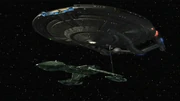
On its way to apprehend the rogue Human Augments in 2154, Enterprise disables a D5-class battle cruiser
The Klingon Empire nearly went to war with Earth during the Augment Crisis a year later, in May 2154, when a group of genetically-engineered Humans hijacked a Klingon Bird-of-Prey and ejected its crew into space. In response, the Empire sent scout ships to the vicinity of the Human Proxima colony. Planning to devastate Humanity, the Augments tried to escalate the incident by annihilating the Klingon Qu'Vat Colony with a biogenic weapon. Fortunately, war was averted when Enterprise destroyed the rogue Humans responsible and saved the colony. (ENT: "Borderland", "The Augments")
A short time later, the Klingons found genetic material of the Human Augments within the wreckage of the hijacked Bird-of-Prey. Fearing that Starfleet may be attempting to create genetically superior Humans to take over the Empire, they tried to adapt this genetic engineering to improve themselves. An unanticipated side effect was that the Augment DNA caused the Klingon cranial ridges to dissolve. The test subjects did gain increased strength and intelligence, but then their neural pathways started to degrade and they died in agony. One of the subjects was suffering from the Levodian flu, which was modified by the Augment genes to become a deadly, airborne plague that spread rampantly within the Empire, posing its gravest threat since the Hur'q invasion. In the first stage of this plague, a Klingon's physiology mutated to become more Human, for which the degeneration of the cranial ridges was a symptom.

A Klingon suffering from the Klingon augment virus in 2154
With the help of a Klingon scientist named Antaak, Dr. Phlox of the Enterprise was able to formulate a cure that halted the genetic effects of the virus in the first stage, retaining the changes in appearance along with some minor neural re-ordering, but with no development of stage two characteristics, such as enhanced strength, speed or endurance. This left millions of Klingons, mostly in the warrior caste, without their ridges. As these alterations were even passed on to their children, Phlox and Antaak theorized that surgical cranial reconstruction might become quite popular for Klingons who would want to restore their outer appearance. (ENT: "Affliction", "Divergence")
It remains unclear when and if a final cure for the Augment virus was found. Any Klingon shown originally without cranial ridges in TOS and then with them in subsequent time periods (e.g. Kang, Koloth, and Kor), might simply have undergone surgical reconstruction of their cranial ridges. Other differences in attitude and methodology between the TOS and non-TOS Klingons can perhaps be attributed to the neural re-ordering caused by the virus.
Second half of the 22nd century[]
Starting around the middle of the century, encounters between Klingons and Starfleet became more rare. (DIS: "The Vulcan Hello")
The episode specified that this era of few encounters had lasted "almost a century". The episode is set in 2256, so the period would have begun at some point after 2156, shortly after the final Klingon encounter depicted in Star Trek: Enterprise, in "Divergence" (set in 2154). It might be linked to the two events of the era that no doubt would have huge consequences for the Empire: the Augment crisis and the founding of the United Federation of Planets. The lack of context is also likely connected to Sarek's statement that "their Empire has been in disarray for generations."
23rd century[]
Klingon-Federation hostilities[]
- See also: Human-Klingon history
Cold and hot wars[]
In 2223, Klingon-Federation relations had degraded to a point where both powers were in a state of constant unremitting hostility. Although encounters with the Federation were very rare since the mid-22nd century, they included a Klingon "terror raid" on Doctari Alpha in 2236, as well as the inconclusive Battle of Donatu V in 2245. As there was barely any communication between both sides during this period, almost no one in the Federation had seen a Klingon up until 2256. (ENT: "In a Mirror, Darkly, Part II"; DIS: "The Vulcan Hello"; TOS: "The Trouble with Tribbles"; Star Trek VI: The Undiscovered Country)
In the 2230s, the Klingons engaged in time travel research. Starfleet's Section 31 division learned of this research and feared the Klingons would use time travel to wipe out Humanity before it even evolved. As part of a "temporal arms race", Section 31 initiated the Daedalus Project to develop its own time travel capabilities and procured a Klingon time crystal on the black market. The time crystal was brought to Doctari Alpha for research. However, the Klingons managed to trace it, prompting the aforementioned attack on the outpost. (DIS: "The Red Angel", "Perpetual Infinity")
It is not clear what happened around 2223, a date derived from the Star Trek VI: The Undiscovered Country comment about there having been "almost seventy years of unremitting hostility" between the Federation and the Klingons. For a long time, it was assumed that this was the general date of first contact with the Klingons, a hypothesis endorsed by reference works such as the Star Trek Encyclopedia, 3rd ed., p. 244, which placed first contact in 2218 based on an analogous line cut from the script of "Day of the Dove", describing "Fifty years – eyeball to eyeball with the Klingon Empire"). Star Trek: Enterprise negated this theory by placing Human-Klingon first contact in 2151.
Additionally, it might seem hard to explain the period between 2223 and 2256, which is claimed to be characterized by "unremitting hostility" in Star Trek VI: The Undiscovered Country and "In a Mirror, Darkly, Part II", but said to be part of a century with barely any contact in "The Vulcan Hello". It can only be surmised that, before 2223, the Federation rarely encountered Klingons but contacts might not always be hostile, whereas starting with the relations breakdown in 2223, all contacts, while still rare, were hostile.

A star chart showing the situation of the war against the Federation in 2256
As of 2256, the twenty-four Klingon Great Houses were waging war on each other, the Empire having been in disarray for generations. However, in that year, T'Kuvma, a Klingon of noble heritage but not a member of the High Council, successfully started a Federation-Klingon War by provoking – and being martyred at – the Battle of the Binary Stars. Under the creed "remain Klingon", T'Kuvma, as the first Klingon since Kahless, thereby managed to rally the Empire to a common cause as he had portrayed the Federation as an existential threat, whose space had encroached unacceptably close upon that of the Klingons. (DIS: "Battle at the Binary Stars")
Until his ship was destroyed, the war propelled General Kol of the House of Kor to the top of the High Council, partially via the dissemination of early cloaking screens to loyal commanders as leverage. (DIS: "Choose Your Pain", "Lethe") After Kol's death, the Empire again was without clear leadership; this did not end the war, however, as the various Great Houses separately tried to inflict as much damage as possible on Federation targets, including the destruction of an entire colony, the capture of Starbase 1, and attacks on hospitals and food convoys. (DIS: "The War Without, The War Within")
The Battle of Caleb IV, including Kor commanding a D5-cruiser, is mentioned in DS9: "Once More Unto the Breach" and was indirectly implied by Kor to have taken place when cloaking technology was a novelty in the Klingon fleet. Therefore, it might have been part of the Klingon-Federation War of 2256/2257.

Chancellor L'Rell assumes the title of "mother" in 2257
The war concluded in 2257, when Starfleet desperately resorted to a direct assault on Qo'noS after it had lost one-third of its ships and twenty percent of Federation territory was under Klingon control. Without official orders, the commander of the assault planted a hydro bomb within the underground volcano system of Qo'noS. However, the detonator was eventually handed to L'Rell, an early follower of T'Kuvma, who used it to seize power over the Empire and continue her former mentor's work of uniting the disparate Great Houses. (DIS: "Will You Take My Hand?") The war was then ended by a peace accord in Paris on Earth, and L'Rell became the High Chancellor. (DIS: "Brother")

L'Rell presents the new D7-class design to the High Council in 2257
As Chancellor, L'Rell attempted to further unify the Empire by developing a new type of warship, the D7-class, for use throughout the Klingon Imperial Fleet, replacing various designs used by the Great Houses. Opposition to her chancellorship remained, however, and L'Rell's torchbearer, Ash Tyler, warned the Federation that insurrection might be brewing in the High Council and that, if L'Rell fell, so would peace. Eventually, Kol-Sha of the House of Kor found a weakness of L'Rell, by finding her son, and moved to take over. Section 31 intervened to stop Kol-Sha and helped L'Rell consolidate power by helping fake the death of both her torchbearer and son. (DIS: "Point of Light") L'Rell later permitted Christopher Pike to travel to Boreth and acquire a time crystal from the monks. (DIS: "Through the Valley of Shadows") At the behest of Tyler, L'Rell also agreed to provide ships for a battle against a Section 31 fleet commanded by "Control" and personally led a cleave ship during the fight. (DIS: "Such Sweet Sorrow, Part 2")
Renewed escalation and tenuous peace[]
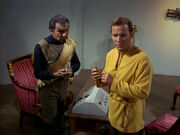
Kor, commander of the Klingon forces occupying Organia, and Starfleet Captain Kirk learn of the cease-fire "enforced" by the Organians in 2267
Despite this minor cooperation, relations between the Federation and the Empire remained tense. In 2267, negotiations broke down and both sides declared war. Again, the Klingons launched an immediate offensive, seizing several planets, including the strategically important planet Organia. Unexpectedly, this new Federation-Klingon War was brought to a sudden conclusion just days after it had begun, when the Organians, noncorporeal beings who had covertly observed both Klingons and Humans more than a hundred years earlier, intervened. By rendering all weapons inoperative, they forced an end to all hostilities and an Organian representative simultaneously appeared before the Klingon as well as the Federation leaders on Qo'noS and Earth, respectively. The Treaty of Organia was then imposed, establishing a neutral zone that separated the two powers and instituting a procedure, to be overseen by the Organians, through which planets along the border could be claimed and settled by both sides. (ENT: "Observer Effect"; TOS: "Errand of Mercy", "The Trouble with Tribbles"; DS9: "Apocalypse Rising")
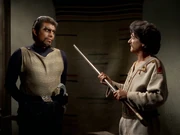
Krell's attempt to establish imperial rule over Neural via escalating tribal infighting failed in 2268.
Despite the Treaty of Organia, a number of confrontations, albeit of limited scope, between the Klingons and the Federation occurred over the next decade. These included hostile encounters at Capella IV, the Delta Triangle, Neural, Elas, and Beta XII-A, as well as disputes over Sherman's Planet and the Archanis sector, both of which were eventually ceded to the Federation. In most of these confrontations, the Klingons tried to gain a strategic advantage and/or secure mining rights for valuable minerals, such as dilithium and topaline, often by manipulating indigenous populations. (TOS: "Friday's Child", "The Trouble with Tribbles", "A Private Little War", "Elaan of Troyius", "Day of the Dove"; TAS: "More Tribbles, More Troubles", "The Time Trap")
In "The Trouble with Tribbles", Spock states that the dispute over the area around Sherman's Planet began immediately after first contact with the Klingons, meaning that the political status of this region of space must have been unclear since the 2150s or possibly even 2016.

In 2286, the Klingon ambassador demands that the Federation Council extradite the "terrorist" James T. Kirk
Although a certain relaxation in their relations was indicated by the Klingon Empire formally relinquishing its claim on the Archanis sector to the Federation around 2272, tensions between the two again came to a head in the 2280s, with the revelation of the secret Project Genesis. While this was devised as a scientific program developing an advanced method of quickly terraforming worlds, it could also be abused as a weapon of mass destruction. While the Klingon Empire was negotiating openly with the Federation, a Bird-of-Prey under the command of Commander Kruge tried to covertly obtain the secrets of the Genesis Planet. The Klingons planned to accuse the Federation of duplicity in developing Genesis as a weapon of awesome power and using the negotiations as a cover. (Star Trek III: The Search for Spock; DS9: "Broken Link") However, when the crew of the USS Enterprise, commanded by James T. Kirk, managed to capture the Bird-of-Prey, the Klingon Ambassador proclaimed a vendetta against Kirk in 2286, vowing, "There shall be no peace, so long as Kirk lives!" (Star Trek IV: The Voyage Home)

Klingon General Korrd with Human and Romulan ambassadors Talbot and Dar aboard the Enterprise in 2287
Because of this, as well as Kirk's previous history with the Klingon Empire, some Klingons considered him a revered figure and worthy opponent. In 2287, Commander Klaa took advantage of a hostage situation on Nimbus III that involved the "Galactic Army of Light", which captured local Klingon representative General Korrd, as well as his Human and Romulan colleagues, St. John Talbot and Caithlin Dar, to extort access to a starship. Seeking battle with Kirk, the subsequently commandeered USS Enterprise-A was immediately pursued by Klaa's Bird-of-Prey all the way to Qui'Tu beyond the Great Barrier at the center of the galaxy. However, General Korrd, who was aboard the Enterprise, stopped Klaa from continuing his renegade personal undertaking and the crisis was eventually solved by an unusual cooperation between the Klingon ship and the Enterprise. (Star Trek V: The Final Frontier)
By 2290, the captain of the IKS T'Ong still had standing orders to fire on all Federation starships. (TNG: "The Emissary")
Intermittent developments[]
On stardate 4326.3, Orion merchant raiders attacked Klingon strategic material outposts in the Shepard sector. However, in what later became known as the Feira incident, the Klingon patrol forces under the command of Korrd were unable to stop the Orions, resulting in Korrd to fall into disgrace with the High Council. (Star Trek V: The Final Frontier okudagram)
While no definite transformation is possible, stardate 4326.3 should fall within the 2260s.

A D7-class battle cruiser, which was stated to be originally of Klingon design, equipped with Romulan cloaking technology
Primitive cloaking screens were employed on Klingon vessels as early as 2256, but Starfleet was eventually able to penetrate them. (DIS: "The Vulcan Hello", "Into the Forest I Go") However, by 2268, Klingon D7-class battle cruisers were used by the Romulans, who retrofitted them with new cloaking devices that rendered Starfleet tracking sensors useless. (TOS: "The Enterprise Incident") The following year, Starfleet, specifically Commander Spock, assumed the IKS Klothos under Commander Kor to possess cloaking capability when trying to explain its complete disappearance from sensors. (TAS: "The Time Trap") Years later, Kor reminisced that, when his ship had been equipped with a cloaking device, it had still been considered a very new technology in the Empire. (DS9: "Once More Unto the Breach")
In 2271, Kor led the Klingon Empire to a memorable victory over the Romulan Star Empire in the Battle of Klach D'kel Brakt. (DS9: "Blood Oath") By 2292, Romulans and Klingons regarded each other as "blood enemies". (TNG: "Reunion")
Spock specifically identifies some Romulan D7-class battle cruisers in "The Enterprise Incident" to be of Klingon design. This, as well as the Klingons (specifically, Kor's Klothos) allegedly possessing effective cloaking capability the following year might indicate some sort of technology exchange between both Empires. The Battle of Klach D'Kel Brakt fought between Klingons and Romulans in 2271, just two years later, seems to imply that their relations were in particular flux during this time.
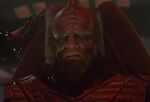
The captain of the IKS Amar, which was neutralized by V'Ger in the 2270s
On two occasions in the 2270s and 2280s, Klingon vessels fell victim to space probes of at least partially unknown origin, which eventually turned out to be Earth-bound. In the 2270s, the entity V'ger fought with and neutralized three K't'inga-class cruisers whereas another mysterious probe disabled two Klingon vessels in 2286. (Star Trek: The Motion Picture; Star Trek IV: The Voyage Home)
An infamous criminal called "The Albino" launched numerous raids against Klingon colonies, prompting the Empire to dispatch three battle cruisers under the commands of Kor, Kang, and Koloth to apprehend him in 2290. Although his raids were stopped, The Albino could not be captured and soon took revenge against the three commanders by killing their firstborn sons. (DS9: "Blood Oath")
In 2297, it was a Klingon expedition that made first contact with the Ventaxians. Hired Klingon craftsmen went on to construct homes on Ventax II. (TNG: "Devil's Due")
Lasting peace with the Federation[]
Although negotiations had proceeded intermittently since the imposition of the Organian Peace Treaty in 2267, no major progress was made in establishing any firm relationship between the Klingons and the Federation. In that same year, a brief but ultimately unsuccessful thawing in relations occurred between the Federation, the Klingon Empire, and the Romulan Star Empire, with the founding of a jointly managed colony on Nimbus III. Dubbed the "planet of galactic peace," the colony quickly became an embarrassing failure for all three governments, although regular meetings, including Klingon representative General Korrd, did take place at the colony for at least the next twenty years. (Star Trek V: The Final Frontier)
A more notable meeting, on the other hand, was a series of negotiations at the Korvat colony in 2289, where Federation mediator Curzon Dax met with Kang. No lasting agreement was reached at this meeting, but Dax did manage to gain grudging respect from the Klingons and establish a lasting rapport. (DS9: "Blood Oath")

In 2293, Chancellor Gorkon raises a toast to "the Undiscovered Country – the future..."
The situation abruptly changed with the explosion of the Klingon moon Praxis in 2293. The disaster caused major problems for the Klingon economy and military, as well as a major ecological crisis on Qo'noS itself. The Chancellor of the Klingon High Council, Gorkon, took the controversial move of proposing a full peace treaty and establishing a process for dismantling the military fortifications and outposts along their mutual border – the military emplacements and warships that the Klingons could no longer afford.
However, peace did not come easily. While en route to a meeting with the Federation President on Earth, Gorkon was assassinated by two crewmen from the Enterprise-A who were part of an extensive conspiracy opposed to any peace treaty between the two enemies and including members of both sides, such as Admiral Cartwright and General Chang, as well as Romulan Ambassador Nanclus. Gorkon's daughter, Azetbur, was appointed as the new chancellor in her father's place. Despite enormous pressure from her advisers to abandon the peace initiative, she chose to press forward and see her father's vision fulfilled.

The Khitomer Conference of 2293 paved the way for a lasting Klingon-Federation peace
The ensuing Khitomer Conference resulted in the signing of the Khitomer Accords, a treaty which became the foundation for peace between the Federation and the Klingon Empire. For the Romulans on the other hand, it would become a defining motive of the coming decades to re-shift the balance of power by sabotaging this peace. (Star Trek VI: The Undiscovered Country; TNG: "Reunion", "The Mind's Eye")
24th century[]
Klingon-Federation détente and Romulan aggression[]
Despite the Khitomer Accords of 2293, Klingon-Federation relations remained rocky for the following decades, although negotiations for a new peace treaty had begun by 2344. (TNG: "Yesterday's Enterprise")
There has not yet been any canon information on Klingon history between 2293 and 2344. However, non-canon sources such as the Lost Era novel The Art of the Impossible place intermittent conflicts with the Cardassians, including the Betreka Nebula Incident, within this timeframe.
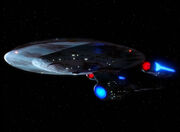
The sacrifice of the USS Enterprise-C in 2344 proved instrumental in maintaining and expanding the détente between the Klingon Empire and the Federation
That same year, a single courageous act by the crew of a Federation starship finally changed relations for the better, when the USS Enterprise-C responded to a distress signal from the Klingon outpost on Narendra III, which was under attack by the Romulans. Despite overwhelming odds, the Enterprise-C rushed to the rescue and was destroyed. The crew's conspicuous heroism and ultimate sacrifice, in attempting to protect potential enemies, left a lasting impression on the Klingons, paving the way to further rapprochement towards the Federation. (TNG: "Yesterday's Enterprise")
It had not been exactly clarified how tense the relations between the Empire and the Federation really were by 2344. As the temporary removal of the Enterprise-C from the primary timeline resulted in a fierce war between the two powers in an alternate 2366, we might assume that the situation was very volatile, despite the ongoing talks for a new peace treaty. Although never established in canon, this treaty had been theorized to be the later mentioned Treaty of Alliance.
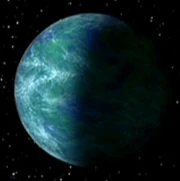
Khitomer – planet of fate for the Klingons (as seen in 2293)
In 2346, two years after its attack on Narendra III, but at a time when it was supposed to be "an ally" of the Klingons, the Romulan Star Empire attacked the Klingon planet Khitomer and killed almost all of the 4,000 colonists. The raid was made possible by the traitor Ja'rod of the House of Duras, who supplied the Romulans with the deactivation codes of the colony's defensive shields. With the USS Intrepid it was again a Federation vessel to be the first ship responding to the distress signal. In order to protect the powerful House of Duras, the treason would later be blamed on another colonist, Mogh. 23 years later, Worf, son of Mogh, would discover a Romulan prisoner camp on Carraya IV in the hopes of finding his father there. After learning that Mogh died in the original attack, Worf agreed to keep the camp a secret as the Klingon prisoners had adapted to a peaceful coexistence with the Romulan guards and thereby dishonored themselves. (TNG: "The Neutral Zone", "Sins of The Father", "Birthright, Part II")
The remark on a possible Klingon-Romulan Alliance at the time of the Khitomer Massacre is based on the TNG episode "The Neutral Zone," in which Worf states, "Romulans killed my parents in an attack on Khitomer, at a time when they were supposed to be our allies." It is plausible to assume that their official relations have been very erratic over the 23rd and 24th centuries (see Romulan-Klingon relations).
In 2350, Romulan forces made a foolhardy attempt to board Klingon General ShiVang's flagship. Following the ensuing battle, Martok, future Chancellor of the Klingon High Council, was given a battlefield commission in the Klingon Defense Forces. That same year, a Klingon attack cost the lives of later Romulan Praetor Neral's family. (DS9: "Once More Unto the Breach", "Inter Arma Enim Silent Leges")
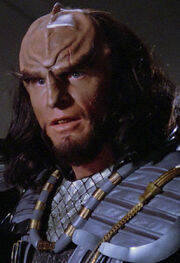
Disapproving of the Empire's peaceful attitude, Korris and others went rogue to seek glory elsewhere.
Around 2349, relations between the Klingon Empire and the Federation were still described as "not too cordial." (VOY: "Faces") The mediator Riva gained fame for negotiating several treaties between the Federation and Klingon Empire; before Riva, there was no Klingon word for "peace-maker." (TNG: "Loud As A Whisper") By 2353, the Treaty of Alliance was signed, finally establishing a firm friendship between the two former enemies – just as the Organians had predicted almost eighty years before. Sarek of Vulcan as well as his son Spock were key figures in devising and negotiating the treaty. (TNG: "Yesterday's Enterprise", "Sarek"; DS9: "The Way of the Warrior"; VOY: "Alliances") The Klingons even joined the Federation in some fashion, some time after 2327 but before 2365. (TNG: "Samaritan Snare") Despite the alliance, as late as 2362 there were still Klingon raids against Federation targets. (TNG: "Aquiel") As of 2364, certain Klingons such as Korris, were disillusioned with the attitude of peace within the Empire, going as far as to call their leadership traitors and go rogue. (TNG: "Heart of Glory")
The comment on the Klingons being some part of the Federation made in "Samaritan Snare" may be in fact referring to the "Treaty of Alliance," creating a firm alliance between the two powers.
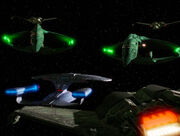
Klingon Birds-of-Prey assist the Enterprise-D against Romulan Warbirds in 2366
The Klingon-Federation alliance was not just a powerful political statement, but also enabled several strategic cooperations. As part of an Officer Exchange Program, Klingon as well as Starfleet personnel served aboard each other's vessels during the 2360s, including Commanders William T. Riker and Kurn, but also exobiologist J'Dan, who turned out to be spying on behalf of the Romulans, however. (TNG: "A Matter Of Honor", "Sins of The Father", "The Drumhead") In 2365, a Klingon cruiser passed on information to Starfleet about debris of the ancient Earth vessel Charybdis which it had detected at Theta VIII. (TNG: "The Royale") Later that year, the USS Enterprise-D and special emissary K'Ehleyr assisted the Klingon Empire in retrieving the sleeper ship IKS T'Ong, which had been dispatched on a "crucial" long-range mission in 2290 and, thus, was unaware of the peace between the Klingons and the Federation. (TNG: "The Emissary") The following year, three Klingon Birds-of-Prey assisted the Enterprise-D in escaping a hostile situation against two Romulan Warbirds in orbit of Nelvana III. (TNG: "The Defector") In 2368, the Klingon Empire provided a Bird-of-Prey to Captain Picard and Lieutenant Commander Data, who required cloaked passage to Romulus for a covert mission. (TNG: "Unification I", "Unification II")
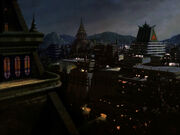
The Klingon colony on Krios in 2367
The Klingon-Federation alliance remained a thorn in the flesh of the Romulan Star Empire, and its dissolution, or ideally a new Klingon-Federation war, was an important strategic aim for the Romulans and an appealing alternative for some Klingons, who thought they had become weak due to the alliance. While a cooperation between Romulan Commander Sela and Klingon Ambassador Kell in 2367, which was intended to frame Starfleet for providing weapons to separatist rebels on the Klingon colony Krios and even murdering the local governor Vagh, was unveiled and thwarted, other attempts at subterfuge culminated in the Klingon Civil War (see below). (TNG: "Reunion", "The Drumhead", "The Mind's Eye")
Civil war[]
- Main article: Klingon Civil War
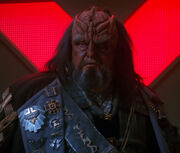
K'mpec, Chancellor of the Klingon High Council in 2366
Despite the establishment of a full peace treaty with the Federation, the Empire did not remain at peace for very long. During the reign of K'mpec, the longest-reigning ruler in Klingon history, two rival factions developed in the Klingon High Council. One, led by Duras, who was also secretly allied with Romulan interests who were seeking to split the Federation-Klingon alliance, advocated setting an independent and aggressive policy. In 2366, K'mpec, with the help of Worf, even had to conceal the treason committed on Khitomer twenty years earlier by Duras' father, Ja'rod – simply to avert civil war. The other faction was led by Gowron and favored continuing the peaceful relationship with the Federation. After K'mpec died of poisoning in 2367, the two factions were on the verge of starting a new civil war. (TNG: "Sins of The Father", "Reunion")
Although Duras was killed by Worf, Duras' sisters, Lursa and B'Etor, continued the struggle in their brother's place. They presented Toral, the illegitimate son of Duras, to challenge Gowron for leadership of the Council. Because the majority of the Council had been corrupted by the House of Duras, they sided with the Duras sisters and walked out of the Council when Arbiter of Succession Jean-Luc Picard rejected Toral's claim, making official the division of the Empire. (TNG: "Redemption")
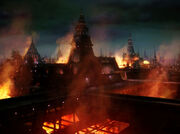
The First City on Qo'noS burns during the Klingon Civil War in early 2368
The civil war, when it finally broke out, was as bold and bloody as any other conflict in Klingon history. The warriors of the Empire threw themselves into the fight with typical zeal – for example, Kurn was heard to shout, "Our time for glory is here!" In the first three engagements, the forces allied with the Duras family decisively defeated Gowron's allies. However, it was not generally realized at the time that the Duras forces were secretly receiving material aid from the Romulan Star Empire, namely from Commander Sela and General Movar. The Romulans hoped that a victorious Duras family would end the Federation-Klingon alliance, creating a new Klingon-Romulan alliance to shift the balance of power in the quadrant.
However, Starfleet recognized the probability that the Romulans were interfering in the conflict. Jean-Luc Picard and the Enterprise-D led a fleet of starships to the Romulan-Klingon border, establishing a blockade and preventing the Romulans from sending the Duras forces further assistance. When the Romulan connection was finally revealed, support quickly fell away from the Duras family, and Gowron successfully reunited the Empire under his leadership. Although he generally kept a pro-Federation stance for the time being, Gowron quickly moved on to "rewrite" history in order to downplay Starfleet's part in his victory. (TNG: "Redemption II", "Unification I")
Borg threat[]
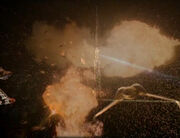
A battle between the Klingon Defense Force and a Borg cube
In 2366, the Federation was attacked by a Borg cube. Shortly before the ensuing Battle of Wolf 359, Starfleet requested Klingon assistance for Admiral J.P. Hanson's fleet awaiting the attacking Borg cube. Apparently, the battle began before the Federation fleet could be reinforced. After the destruction of Hanson's taskforce, Locutus of Borg stated that "the Klingons will also be assimilated." (TNG: "The Best of Both Worlds, Part II") A number of Borg drones of Klingon origin encountered by the crews of the USS Enterprise-E and the USS Voyager indicated that the Empire, too, had been exposed to the aggression of the Borg Collective. Voyager's first officer Chakotay, during a neural link with the Cooperative, became aware of at least one pitched battle the Empire fought against a Borg cube of the same type that engaged Starfleet in the Battle of Wolf 359. The Klingon Defense Force fared little better than its Federation counterpart in the battle. (Star Trek: First Contact; VOY: "Unity", "Infinite Regress", "Unimatrix Zero")
The battle scene shown in Unity was stock footage from DS9: "Emissary" and DS9: "The Way of the Warrior", newly edited in post-production.
The "return" of the Emperor[]

The clone of Kahless in 2369
By 2369, the clerics of Boreth had acquired the necessary technology to create a clone of Kahless the Unforgettable using DNA from the Knife of Kirom and imprinting Kahless' memories, as written down in the sacred texts, in the clone's synaptic pathways. The clerics' plan was to counter the corruption and dishonor in the Empire, by restoring a strong leadership and reinstating the position of Emperor of the Klingon Empire. "Kahless'" ascension to this post should follow his faked return from Sto-vo-kor; however, worrying about his chancellorship, Gowron was able to expose the plan of the clerics. Lieutenant Worf then suggested that the clone of Kahless be made Emperor, but only in the sense of a moral leader for the Klingon people with Gowron remaining chancellor of the Klingon High Council. (TNG: "Rightful Heir")
Dominion-instigated conflicts with Cardassia and the Federation[]
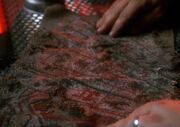
The Shroud of the Sword of Kahless, which was re-discovered in the Gamma Quadrant in 2372
In 2369, the Bajoran wormhole leading to the Gamma Quadrant was discovered – a find with profound implications for the geopolitical situation in the Alpha Quadrant, including the Klingon Empire. The Klingons showed an early interest in exploring the Gamma Quadrant by dispatching scout ships and freighters. The IKS Toh'Kaht was among the first ships to explore the quadrant in an effort to establish colonies beyond the wormhole. After a Vulcan expedition discovered the Shroud of the Sword of Kahless at an ancient Hur'q outpost in the Gamma Quadrant in 2372, Dahar Master Kor, along with Lt. Cmdr. Dax and Worf, set out to find and retrieve the sword itself. Fighting off an attempt to steal the sword by Toral, son of Duras, the three soon realized that its symbolic power would tear the Empire apart and decided to leave it adrift in space in the Gamma Quadrant. (DS9: "Q-Less", "Dramatis Personae", "The Storyteller", "The Sword of Kahless")
The Federation-Klingon alliance was sorely tested in the 2370s, in the wake of the Federation's first contact with the Dominion, a major hegemonic power from the Gamma Quadrant. The leaders of the Dominion, the Founders, had the expressed goal of conquering all of the powers of the Alpha Quadrant, in order to prevent them from ever threatening the Great Link. (DS9: "The Search, Part II") In late 2371, the Dominion captured General Martok, a trusted adviser to Gowron, replacing him with a Changeling impersonator. (DS9: "Apocalypse Rising", "In Purgatory's Shadow")
The Changeling posing as Martok convinced Gowron that the recent civilian uprising in the Cardassian Union had been engineered and supported by the Dominion, and that the uprising heralded an imminent invasion by the Dominion into the Alpha Quadrant. To prevent this invasion from occurring, Gowron launched a massive assault against the Cardassian Union in early 2372. Emperor Kahless condemned the invasion, but was eventually overruled by Gowron, whose goal was to conquer all Cardassian territories to ensure that it could not be taken by the Dominion.
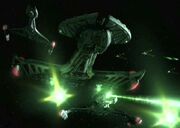
The Klingon flagship Negh'Var attacks Deep Space 9 in early 2372
When the Federation Council protested Gowron's actions, he took it as a betrayal and withdrew from the Khitomer Accords, ending the Federation-Klingon alliance. Although no declaration of official hostilities was made, a state of near-war developed between the two powers. The Klingons even launched a preemptive attack against the Federation outpost Deep Space 9, in order to capture the remaining free members of the Cardassian Detapa Council. However, Deep Space 9 Captain Benjamin Sisko pointed out to Gowron that a war between the Federation, the Klingons, and the Cardassians was exactly what the Dominion wanted – a divided Alpha Quadrant that would be ripe for conquest in the future. Faced with this reasoning, Gowron called an end to the invasion and halted the attack against DS9. In order as not to endanger his position as chancellor, Gowron simply declared victory and returned home. The Klingons also did not leave several captured Cardassian colonies and began fortifying them. (DS9: "The Way of the Warrior", "Hippocratic Oath")
Throughout 2372, the Klingons continuously followed an aggressive posture, systematically looking for weaknesses in systems along their borders, including attacks on several Romulan outposts. From their newly occupied positions in Cardassian territory, Klingon vessels regularly attacked Cardassian targets. They also supplied the Maquis with cloaking devices to further weaken the Cardassians. (DS9: "Indiscretion", "Rules of Engagement", "Hippocratic Oath", "Blaze of Glory")
Simultaneously, the Klingons continued to prepare for a new conflict with the Federation, including an attempt to mine the Bajoran system. (DS9: "Sons of Mogh")
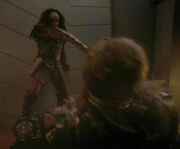
General Martok is revealed as a shapeshifter in early 2373
Finally, in late 2372 and at the Martok Changeling's suggestion, Gowron demanded that the Federation relinquish claims to a number of territories along their mutual border, namely the Archanis sector, or face war. When the Federation Council refused the demands, the Empire launched an invasion with battles fought for Archanis IV, Ajilon Prime, and Ganalda IV. The Federation-Klingon War was brutal, but short – only a few weeks after it began, Gowron called an end to the conflict after a Starfleet covert ops team revealed that Martok was actually a shapeshifter and the entire war had been engineered to divide the two former allies. However, some hostilities continued after the ceasefire and were only ended when the Dominion began its invasion of the Alpha Quadrant. (DS9: "Broken Link", "Apocalypse Rising", "Nor the Battle to the Strong", "By Inferno's Light")
The Dominion War[]
See main article: Dominion War
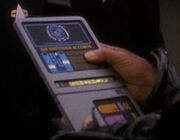
Facing the imminent threat of a Dominion attack, Klingon Chancellor Gowron re-signs the Khitomer Accords in 2373
When the Dominion annexed the Cardassian Union in mid-2373, the Klingons were quickly defeated by the Jem'Hadar and driven from all of their Cardassian conquests. Faced with the prospect of a larger war against a much more powerful enemy, Gowron agreed to re-sign the Khitomer Accords and renew the alliance with the Federation. In addition, a detachment of Klingon soldiers was assigned to Deep Space 9, commanded by the real Martok, who had been rescued from a Dominion internment camp. (DS9: "By Inferno's Light")

Klingon forces relieve the Federation fleet during Operation Return in 2374
The Empire and the Federation ultimately fought side by side in the ensuing Dominion War that broke out in late 2373. Many of the most important engagements of the war were conducted in concert, including the Second Battle of Deep Space 9, the attack on Torros III and Operation Return. (DS9: "Call to Arms", "Sacrifice of Angels")
The anti-Dominion alliance gained new, unlikely allies in mid-2374 when the Romulan Star Empire declared war against the Dominion. Although the Romulans and the Klingons both harbored deep hatred for one another, the two former enemies managed to set their differences aside, in order to successfully fight the Dominion. One of the most decisive victories of this new triple alliance was won at the First Battle of Chin'toka. (DS9: "Tears of the Prophets")
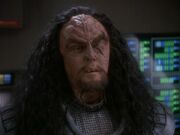
The real General Martok, who commanded Klingon forces in numerous engagements against the Dominion throughout the war
However, ultimate victory eventually came at a very high price. When the Breen Confederacy entered the war in late 2375, the use of the previously-unknown energy-dampening weapon effectively nullified the power of Starfleet and the Romulan forces, wreaking havoc upon their combined fleets, e.g., at the Second Battle of Chin'toka. Klingon ships were the only ones that could be immediately adapted, but despite quickly deploying 1500 vessels the Klingons where still outnumbered twenty-to-one. Rather than fight a holding action, Gowron ordered that Martok launch a full-scale offensive against the enemy, claiming that they had the advantage of surprise. (DS9: "When It Rains...", "The Changing Face of Evil")
Ostensibly, Gowron hoped to achieve quick victory against the Dominion and claim all of the glory for the Empire in winning the war, without the assistance of the Federation or the Romulans. But Gowron's real plan was much more subversive and political. Gowron feared the growing popularity of Martok, who had commanded the Klingon forces on the front lines and was rapidly gaining heroic status among the soldiers of the Empire. Gowron hoped to reclaim some of that popularity for himself, by personally commanding the Klingon war effort from Deep Space 9 and by discrediting Martok in sending him on numerous hopeless missions, e.g., the ill-fated attack on Avenal VII.
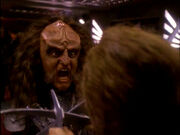
Chancellor Gowron fights Worf to the death in 2375
When no other Klingons protested, Worf challenged Gowron to personal combat, claiming that Gowron was a coward for jeopardizing the very existence of the Empire (and indeed the safety of the entire Alpha Quadrant), in order to satisfy his need for political security. Worf killed Gowron in the fight, thus claiming the right to rule the Empire himself; however, Worf declined the position and nominated Martok instead, who was subsequently proclaimed the new Chancellor of the Klingon High Council. (DS9: "Tacking Into the Wind")
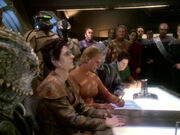
With the signing of the Treaty of Bajor, the Dominion War is finally ended in late 2375
Ultimately, the Empire shared in victory with the Federation and the Romulans, after the final defeat of the Dominion at the Battle of Cardassia in late 2375, during which Chancellor Martok himself led the Klingon forces. Standing amid the ruins of Cardassia, Martok had to drink his bloodwine by himself, however, as Captain Sisko and Admiral Ross lost their thirst in the face of all the destruction and death. (DS9: "What You Leave Behind")
Section 31 estimated that the Klingons would not recover from their losses from the Dominion War until about 2385. (DS9: "Inter Arma Enim Silent Leges")
Alternate timelines[]
In an alternate timeline, created by the death of Benjamin Sisko in 2372, tensions between the Klingons and the Federation, as well as a Bajoran-Cardassian alliance, continued to rise until the Federation decided to hand DS9 to Klingon control to defuse tensions. No Dominion War occurred in this timeline and the Klingons still controlled the station in the early 25th century. This timeline was avoided due to the intervention of Jake Sisko in 2422. (DS9: "The Visitor")
In the anti-time future, the Klingons had conquered the Romulan Star Empire by the late 24th century. Relations between the Klingons and the Federation had deteriorated to the point, that the Klingons had closed their borders to all Federation starships. (TNG: "All Good Things...")
In an alternate timeline, where the Federation fought the Battle of Procyon V against the Sphere-Builders, the Klingons had joined the Federation by the 26th century. (ENT: "Azati Prime")
Mirror universe[]
In the mirror universe, the Klingons had fought against the Terran Empire as early as the 2150s. (ENT: "In a Mirror, Darkly")
By the 2250s, Klingons were part of a rebellion against the Empire together with Vulcans, Andorians and Tellarites. One Klingon, Voq, also known as the Fire Wolf, was even the leader of the rebellion by 2256. Led by Terran emperor Philippa Georgiou, Qo'nos had previously been devastated by a hydro bomb, with Terran vessels firing on ships trying to escape. Georgiou subsequently adopted the title Dominus of Qo'noS. (DIS: "The Wolf Inside", "Will You Take My Hand?")
After the Terran Empire had become less aggressive under the leadership of Spock, the Klingons joined with the Cardassians to form the Klingon-Cardassian Alliance, defeating the Terrans and taking over former Terran territories, including the Bajoran system. The Alliance was still in place by 2375, though it was faced with a growing Terran Rebellion. (DS9: "Crossover", "The Emperor's New Cloak")
Alternate reality[]
In 2258 of the alternate reality, 47 Klingon warbirds were destroyed by the Narada, a Romulan mining vessel from 2387 of the prime reality. Nyota Uhura received the transmission, allowing her to verify James T. Kirk's suspicions that the ship was making a reappearance over Vulcan. (Star Trek)
By 2259, relations between the Federation and the Klingons were not good. After the Federation had learned of the existence of the Klingons, the Empire had conquered and occupied two planets and its ships had engaged in conflict with Starfleet ships numerous times. Believing that war with the Klingons was imminent, Starfleet admiral Alexander Marcus recruited Khan Noonien Singh to design warships and weapons, including the unmarked Dreadnought-class USS Vengeance. Khan betrayed Marcus and transported himself to an uninhabited region of Qo'noS. Captain Kirk, Spock, and Uhura tried to capture him without alerting the Klingons, but were unsuccessful. Khan came to their rescue, single-handedly killing the Klingons before submitting to the Starfleet officers. Afterwards, Marcus warned that the incident would further exacerbate tensions between the Federation and Klingon Empire. (Star Trek Into Darkness)
Timeline[]
- 10th century: Time of Kahless – After slaying the tyrant Molor using the first bat'leth, Kahless the Unforgettable founds the First Empire, becoming its first emperor.
- 14th century: Hur'q invasion – A race from the Gamma Quadrant, which the Klingons call Hur'q, invade Qo'noS. When they leave, they steal valuable artifacts, including the Sword of Kahless. Also during that century "Klingon warriors, set out and slew all of their gods, because they were more trouble than they were worth".
- At least several centuries before the 24th century: "The Dark Time" – Emperor Reclaw and the imperial family of the Second Dynasty are killed by General K'Trelan. For ten years, the Empire enters "The Dark Time" when it is ruled by a council elected by the people, until a Third Dynasty mimicking the Second is installed to rule the Empire.
- 2016: After the Klingons destroy a Vulcan starship, the latter react with a strict fire-first-policy, which earns the Vulcans respect and eventually leads to formal diplomatic relations.
- Mid-21st century: The reign of the last Emperor ends and the lead of the Empire falls to the Chancellor of the Klingon High Council.
- 2133: After losing the crew of a starship, the Klingon High Council forbids all its ships any attempt to enter the Delphic Expanse.
- 2151: First contact with Earth is initiated when Enterprise NX-01 assists Klaang at proving that the Cabal is trying to destabilize the Empire as part of the Temporal Cold War.
- 2152 & 2153: Jonathan Archer of the Enterprise evades Klingon authorities three times after repeatedly "interfering" with the Empire's politics.
- 2154: Augment Crisis – Enhanced Humans try to annihilate Qu'Vat Colony, but ultimately fail in their attempt to ignite a war between the Empire and United Earth. The Empire then uses residue of the Human DNA to breed augmented warriors of its own, but inadvertently creates a virus causing generations of Klingons to lose their cranial ridges amongst others. Sometime hereafter, Klingon-Federation encounters became very rare up until 2256.
- 2223: Federation-Klingon Cold War – Relations between the Empire and the United Federation of Planets degenerate starting a tense cold war.
- 2236: A time crystal is lost during a Klingon raid on a Federation research group on Doctari Alpha, temporarily halting both side's competitive research into time travel.
- 2245: The inconclusive Battle of Donatu V is fought between the Klingon Empire and the Federation.
- 2256: Provoked by Klingon noble T'Kuvma to stop the infighting among his people, the Empire starts a fierce, open war against the Federation.
- 2257: The war ends with a peace accord in Paris. T'Kuvma's follower L'Rell becomes High Chancellor and proceeds to further unite the Klingon people.
- 2267: After engaging in another brief open conflict, the Klingon Empire and the Federation sign the Treaty of Organia establishing ground rules for further interaction and the resolution of territorial disputes, e.g. over Sherman's Planet. That same year, the Empire, the Federation, and the Romulan Star Empire jointly establish a colony on Nimbus III, officially declaring it 'the planet of galactic peace'. Despite this, skirmishes between the Federation and the Klingons persist over the coming years.
- 2271: Empire forces under Kor achieve a memorable victory over the Romulans at the Battle of Klach D'kel Brakt.
- 2272: The Klingon Empire relinquishes its claims on Archanis IV to the Federation.
- 2285 & 2286: Fearing it to be a new devastating Federation weapon, a diplomatic incident involving James T. Kirk arises over the Empire's attempt to gain information about the Genesis Device.
- 2289: The Federation and the Klingon Empire hold a diplomatic meeting at Korvat colony, however without producing any substantial results.
- 2290: The Albino raids Klingon colonies but three battle cruisers commanded by Kor, Kang, and Koloth fail to apprehend him. That same year, the sleeper ship IKS T'Ong, with standing orders to fire on any Federation vessels, is dispatched on a "crucial" long-range mission from which it would not return until 2365.
- 2292: By this year, the Romulans are considered "blood enemies" in the Klingon Empire.
- 2293: Khitomer Accords – The explosion of the Klingon moon Praxis causes an ecological disaster, disposing Chancellor Gorkon to pursue a full peace treaty with the Federation. Despite the subsequent assassination of Gorkon, his daughter and new Chancellor, Azetbur, participates at the Khitomer Conference, which leads to the Khitomer Accords establishing a lasting peace between the two powers.
- 2297: A Klingon expedition makes first contact with the Ventaxians.
- 2344: Despite ongoing negotiations for a new peace treaty, the Klingon-Federation relations are again tense by this year. The Empire's alliance with the Federation is eventually cemented by the honorable act of the Federation vessel USS Enterprise-C, which responds to a Klingon distress signal from Narendra III and is destroyed while trying to protect the outpost from a Romulan attack.
- 2346: With the help of the traitor Ja'rod of the House of Duras, the Romulans commit the Khitomer Massacre, killing almost all of the 4,000 Klingon colonists on Khitomer.
- 2350: Romulan forces fail in an attempt to board Klingon General ShiVang's flagship. That same year, later Romulan Praetor Neral's family are killed in a Klingon attack.
- 2366: In order to avert a civil war, Klingon Chancellor K'mpec conceals Ja'rod's treason, due to his house's influence in the High Council.
- 2367 & 2368: Klingon Civil War – After K'mpec dies of poisoning, Gowron, opposing the House of Duras, becomes new Chancellor. His position is quickly challenged but eventually affirmed in the brief civil war against the Romulan-supported, but ultimately inferior, House of Duras.
- 2369: A clone of Kahless created by clerics from Boreth assumes the re-created, but now purely representative, position of Klingon emperor, while Gowron remains the Empire's Chancellor and factual leader.
- 2371: General Martok is covertly abducted and interned by the Dominion, while a Changeling replaces him.
- 2372: Led by the Martok-Changeling, the Klingon Empire starts an invasion of the Cardassian Union, which is subsequently condemned by the Federation. Later that year, the Federation's and Klingon's old dispute over the Archanis sector escalates, leading to the Klingon's withdrawal from the Khitomer Accords.
- 2373: The real Martok is freed after the Changeling impersonating him is revealed earlier this year. The Cardassian Union joins the Dominion, swiftly resolving the Klingon's conflict with the Federation and reinstating the Khitomer Accords. Later that year, the Dominion attacks and captures the Federation station Deep Space 9, beginning the Dominion War against the Empire and the Federation.
- 2374: With the aid of Klingon ships sent at the last moment by Gowron, the Federation recaptures Deep Space 9. Later that year, the Romulan Star Empire turns the tide of the war as it joins the Empire and the Federation against the Dominion.
- 2375: The Dominion gains the upper hand in the war again with its alliance with the Breen Confederacy which uses energy-dampening weapons. Due to a technical uniqueness of Klingon vessels, the Empire holds the front on its own for some weeks being outnumbered 20:1. Fearing the growing popularity of the successful General Martok, Gowron tries to discredit him by ordering suicidal missions, but is subsequently killed by Worf. Martok becomes the new Klingon Chancellor and, with the help of the Cardassian Rebellion, the Federation Alliance manages to repel the Dominion forces, finally capturing Cardassia Prime later that year and ending the Dominion war with the Treaty of Bajor.
- 2385: The Klingon Empire fully recovers from its losses during the Dominion War according to an estimate by Section 31.
Appendices[]
See also[]
External link[]
- Klingon history at Memory Beta, the wiki for licensed Star Trek works
Featured revision (876077) • Diff to current • Blurb
